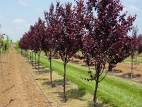|
 |
|
 |
|
 |
 |
 Black knot is a disease that attacks American, European and Japanese varieties of
cultivated plum and prune trees as well as wild cherry. Cultivated sweet and sour cherry
trees are rarely affected. It is found in commercial and home orchards
and on ornamental plum trees. The disease is caused by the fungus, Dibotryon
morbosum, and
it strikes woody parts of the tree including the twigs, limbs and, sometimes, the entire
trunk. Black knot is a disease that attacks American, European and Japanese varieties of
cultivated plum and prune trees as well as wild cherry. Cultivated sweet and sour cherry
trees are rarely affected. It is found in commercial and home orchards
and on ornamental plum trees. The disease is caused by the fungus, Dibotryon
morbosum, and
it strikes woody parts of the tree including the twigs, limbs and, sometimes, the entire
trunk.
|
 |
|
 |
 |
 The common name, "black knot" describes the
main symptom of the disease. The initial symptoms are small, light brown swellings at the
base of leaves, on fruit spurs, and on terminal shoots. These appear during the first year
after infection occurs. These growths enlarge and develop an olive green growth over their
surface. The green color eventually disappears and the knots become coal black and hard.
The knots vary in size, location and shape but they often coalesce into large knots that
cover whole sections of the branch. The common name, "black knot" describes the
main symptom of the disease. The initial symptoms are small, light brown swellings at the
base of leaves, on fruit spurs, and on terminal shoots. These appear during the first year
after infection occurs. These growths enlarge and develop an olive green growth over their
surface. The green color eventually disappears and the knots become coal black and hard.
The knots vary in size, location and shape but they often coalesce into large knots that
cover whole sections of the branch.
Life Cycle - Black knot infections are initiated by spores which
germinate and infect the current year's growth. Infection can occur from green cluster
stage of bud development until tree growth ceases in June. After infection, a light brown
swelling develops during the same year or the following spring. The swelling turns olive
green and produces spores within one or two years after infection.
|
 |
 |
 |
Plant ornamental trees that are not susceptible to
black knot.
|
 |
 |
 |
Since the knots are localized in nature, the disease can
often be controlled by cutting off twigs and branches 4
inches or more below the last visible sign of the knot.
This is generally most effective if done during the
dormant period (winter). On large, main branches or
trunks, knots should be cut out with a sharp knife or
chisel. One inch of healthy bark around the knot should
be included in these cuts. Taper the cuts to a point on
each end to promote proper closing of the wound.
Infected parts removed from the trees should be
destroyed away from the tree.
Spores can develop and
spread from parts left on the ground or in brush piles
nearby. Application of a
fungicide labeled for black
knot control may help prevent further spread. The
fungicide would have to be applied in early spring before the buds open to be effective.
Two additional sprays at 7 to 10 day intervals are generally also recommended. When
planting fruiting or ornamental plum trees, try to obtain varieties resistant to black
knot.
|
|
 |
|
Note: We
have provided some general information and
observations on this topic aimed at the home
gardener. Before you take
any serious action in your landscape, check
with your state's land grant university's
Cooperative
Extension
Service for the most current,
appropriate, localized recommendations. |
|
 |
 |

|
Some fruiting and ornamental plum cultivars:
|
-
Very Susceptable: Bluefre, Damson, Shropshire, Stanley.
-
Moderately Resistant: Bradshaw, Early Italian, Fellenberg, Formosa, Methley, Milton, Santa
Rosa, Shiro
-
Resistant: President
|
 |
|



